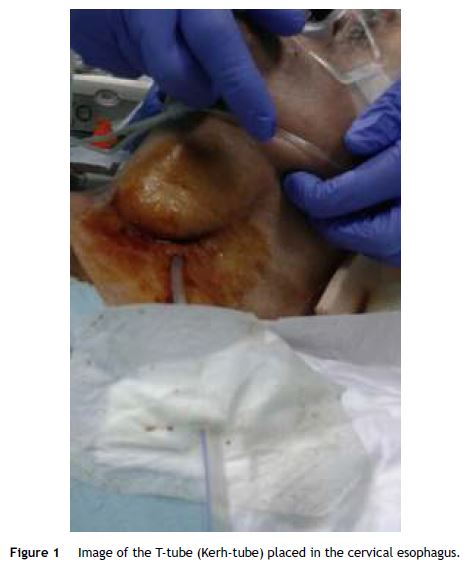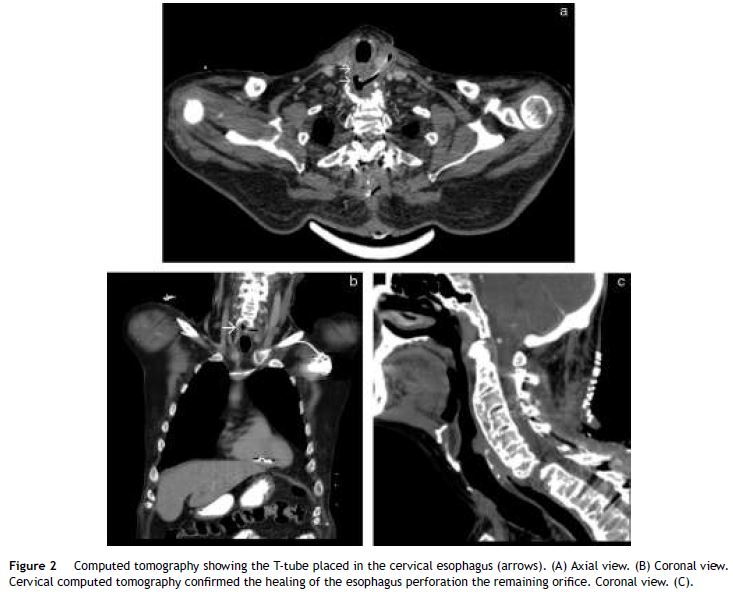Serviços Personalizados
Journal
Artigo
Indicadores
-
 Citado por SciELO
Citado por SciELO -
 Acessos
Acessos
Links relacionados
-
 Similares em
SciELO
Similares em
SciELO
Compartilhar
GE-Portuguese Journal of Gastroenterology
versão impressa ISSN 2341-4545
GE Port J Gastroenterol vol.23 no.2 Lisboa abr. 2016
https://doi.org/10.1016/j.jpge.2015.09.007
ENDOSCOPIC SNAPSHOT
Successful Endoscopic Removal of a Kerh-Tube Placed in an Iatrogenic Esophageal Perforation: Push to Pull
Remoção Endoscópica de um Tubo Kerh Colocado Após Perfuração Esofágica Iatrogénica: Push to Pull
Rosa Coelho*, Alexandre Sarmento, Guilherme Macedo
Gastroenterology Department, Centro Hospitalar São João, Porto, Portugal
* Corresponding author.
Keywords: Gastrointestinal Endoscopy; Esophageal Perforation; Esophagus/injuries; Iatrogenic Disease
Palavras-chave: Endoscopia Gastrointestinal; Perfuração Esofágica; Esófago/lesões; Doença Iatrogénica
1. Case description
Esophageal perforation is a rare complication during cervical surgery associated with high morbidity and mortality.1–3 Currently, the treatment of esophageal perforations remains controversial.1 The use of modified T-tube (Kerh-tube) repair can be a therapeutic option associated with a low mortality rate.4
The authors report a 68-year-old man with a cervical spinal cord lesion submitted to an anterior cervical surgery when a plate fixation removal complicated with an iatrogenic cervical esophageal perforation that was immediately diagnosed. A T-tube was inserted into the esophagus following debridement of adjacent wall with its inferior portion extending into the stomach. The esophageal wall was closed loosely about the tube with sutures placed in the nearest healthy submucosa (Figs. 1 and 2A and B). Two weeks later, an upper endoscopy was performed in order to remove the T-tube. Using a polypectomy snare (10 mm, Olympus®) the distal end of the Kerh-tube was grabbed. The external (cutaneous) part of the T-tube was then cutted and the entire tube was distally pulled into the esophagus. Endoscopic extraction of the Kerh-tube was then successfully performed. An orifice, with 6 mm of diameter, localized 18 cm from the upper incisor teeth was observed after drain removal. As it was located in the beginning of the esophagus it was decided not to perform an endoscopic clip closure. Seven days later, a cervical computed tomography (Fig. 2C) confirmed the healing of the esophagus perforation and the remaining orifice. The patient started oral intake without complications.


This is the first case reported in the literature of a successful endoscopic removal of a T-tube in the esophagus. This case highlights the safety, simplicity and efficacy of this procedure avoiding a more invasive technique. Due to the T-tube characteristic form, the authors recommend that before its removal the drain must be pulled down to the esophagus to minimize the risk of esophageal laceration.
References
1. Jones WG, Ginsberg RJ. Esophageal perforation: a continuing challenge. Ann Thorac Surg. 1992;53:534-43. [ Links ]
2. Brinster CJ, Singhal S, Lee L, Marshall MB, Kaiser LR, Kucharczuk JC. Evolving options in the management of esophageal perforation. Ann Thorac Surg. 2004;77:1475-83. [ Links ]
3. Gaudinez RF, English GM, Gebhard JS, Brugman JL, Donaldson DH, Brown CW. Esophageal perforations after anterior cervical surgery. J Spinal Disord. 2000;13:77-84. [ Links ]
4. Linden PA, Bueno R, Mentzer SJ, Zellos L, Lebenthal A, Colson YL, et al. Modified T-tube repair of delayed esophageal perforation results in a low mortality rate similar to that seen with acute perforations. Ann Thorac Surg. 2007;83:1129-33. [ Links ]
Conflict of interest
The authors declare that there is no conflict of interest.
Financial support
The authors declare that did not receive any financial support for this work.
Appendix A. Supplementary data.
The following are the supplementary data to this article at doi:10.1016/ j.jpge.2015.09.007.
* Corresponding author.
E-mail address: rosacoelhoabrantes@hotmail.com (R. Coelho).
Received 19 August 2015; accepted 24 September 2015














